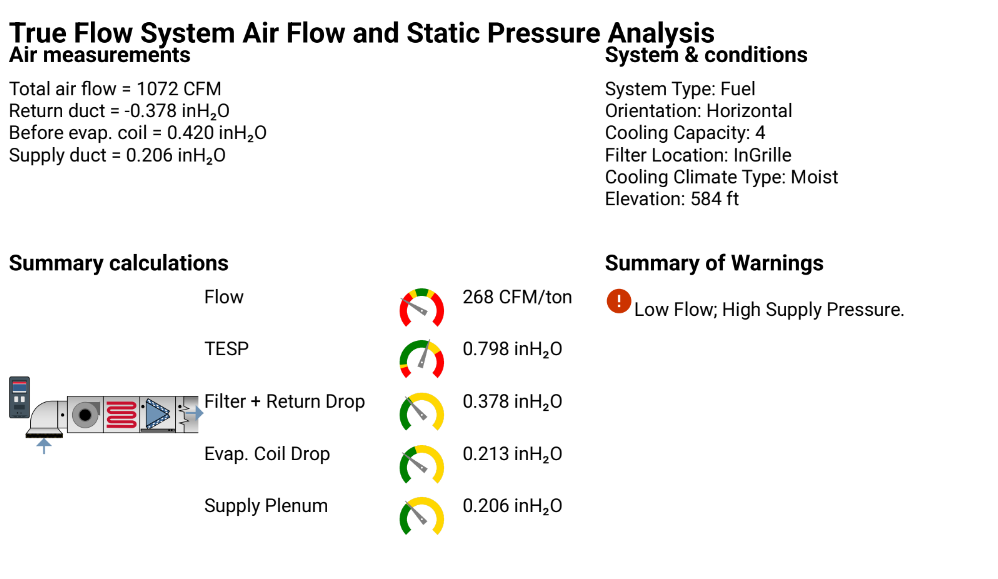Get Tech Tips
Subscribe to free tech tips.
Manual J Field Data: Ducts
Understanding the relationships between ductwork, home comfort, and the load on a house is a complicated and dynamic problem. There are a large number of variables. Some of the data is fairly straightforward, like the other elements of field data collection we have covered so far in this series. Ductwork has different levels of insulation and can be in a conditioned or unconditioned space. Simple enough.
But there are other factors that are difficult to quantify and can have an incredibly dynamic impact, such as how well the duct system is sealed and if the system is inducing a positive or negative pressure on different parts of the home.
The goal here is to size the equipment properly but also to identify opportunities to increase the comfort and efficiency of the system. The more you understand the relationship between the duct system and its effect on the home, the better off you will be, even if we can’t quantify every detail.
The Basics

Manual J will ask you for some very straightforward information about the duct system, like how much insulation the ductwork has and if it’s in a conditioned or unconditioned space. Check to see if the system is air-sealed with mastic. An unsealed system without much insulation can be a huge opportunity for you and the homeowner. Here is a quick look at two duct systems and their load:

Where I live, an older duct system could easily look like the one on the left. To qualify for an “extremely sealed” system, Manual J requires a duct leakage test to be done on completion. But if this duct system was air-sealed and insulated correctly, the load on this house would be reduced by almost 1 ton of cooling. If you are upgrading a duct system, you are very likely reducing the load on the house. Going back with the same-sized piece of equipment would be a mistake.
Capacity Loss and Added Load
There is a whole other side to understanding ductwork that is much more dynamic. A leaky duct system (if it is leaking to an unconditioned space) either adds load on the return side or loses capacity on the supply side. These additions or subtractions of air from the duct system also impact the pressure of the house with reference to the outside. If you are losing supply air, the house goes under negative pressure, whereas if you are sucking in unconditioned return air, your house will be under positive pressure. Neil Comparetto wrote an article several years ago where he addresses what even 10% duct leakage on the supply side alone will do to the load on a house:
Our example system will be a 3-ton air conditioner moving 1200 CFM with ducts in a vented attic. For this exercise, we won’t get into duct sensible heat gain that even a 100% tight duct system will have to overcome.
This system will have a modest 10% supply duct leakage into the attic (Energy Star estimates that the typical duct system has 20-30% duct leakage). Assume 0% return leakage (which is unlikely). So, we already know that 10% of our capacity is gone, never to return to the house again.
On a 3-ton air conditioner, that will be roughly 3,600 BTUH. We are now delivering 1080 CFM of supply air to the living space and returning 1200 CFM. Where does the additional 120 CFM of return air come from? You guessed it: outside. The supply duct leakage into the attic, outside of our thermal and pressure boundary, has now brought the living space into a negative pressure. No big deal; it’s only 120 CFM… but have you ever done the math!?
Neil Comparetto, “Duct Leakage Can Be Costly” (2018)
Fortunately for us, Neil goes on to do the math so that we don’t have to. He concludes that those 120 CFM coming from outside add:
an additional 5,549 BTUH of total heat. The 3,346 BTUH of latent heat is the more difficult number to deal with. Next time you are bored, flip through your favorite air conditioner’s product data and see what it can produce; you may be surprised. Don’t forget about the 3,600 BTUH that’s up in the attic somewhere. Just think: this is from only 10% supply duct leakage; considerably more is likely.
Neil Comparetto, “Duct Leakage Can Be Costly” (2018)
So the conditioned air lost to duct leakage is 3,600 BTUH, plus the 120 CFM of pressure-induced leakage adds another 5,549 BTUH of load to the home. So, the combined effect of just 10% supply duct leakage in Neil’s example is 9,149 BTUH. Around ¾ of a ton!
Now, in a retrofit situation, we may not be able to quantify the duct leakage with exact numbers, but having a general sense of how catastrophic duct leakage can be to system performance is crucial. Here’s a great podcast with Steve Rogers from TEC on it if you want to dig even deeper, and also an excellent article by Allison Bailes on the same topic.
Static Pressure and Airflow
We have yet another layer to add when considering retrofit duct systems. Is the current duct system sized correctly for the air moving through it? Taking some static pressure measurements if the blower motor is still functional is a good idea.
Let’s say you take some static pressure readings. Your total external static pressure is 0.8″ WC, and the blower is rated for 0.5″ WC. So, you have a good idea that the duct system has been under-delivering airflow. Let’s take things one step further. Suppose you have a TrueFlow Grid that can accurately measure airflow. A 4-ton system you measure airflow on is moving 1000 CFM of air at 0.8” WC.

If this system, which “ideally” would be moving 1600 CFM, is moving 1000 CFM, what does that tell me about the actual load on the house? If there have been no comfort complaints and it has been cooling properly on design days, this could be an indication the current system is oversized. The thermostat has been satisfied with much less sensible capacity than a 4-ton with proper airflow would produce.
Conclusion
To spot potential red or yellow flags on a retrofit Manual J, We need to understand the relationship between all of the different elements of a house and the HVAC system. We don’t need to have a deep understanding of the math calculations, but we do need to know what the big factors are that can dramatically affect the load. Ductwork, in many areas, is one of those big factors and can be done in-house, which makes it much easier to do than adding insulation, replacing windows, and other home upgrades.
Many companies already understand this and offer duct upgrades with retrofit replacements. If you are offering significant duct upgrades with retrofits and haven’t considered the reduction this will likely have on the load of a house, it’s time to start doing so.
—Matt Bruner











Comments
To leave a comment, you need to log in.
Log In